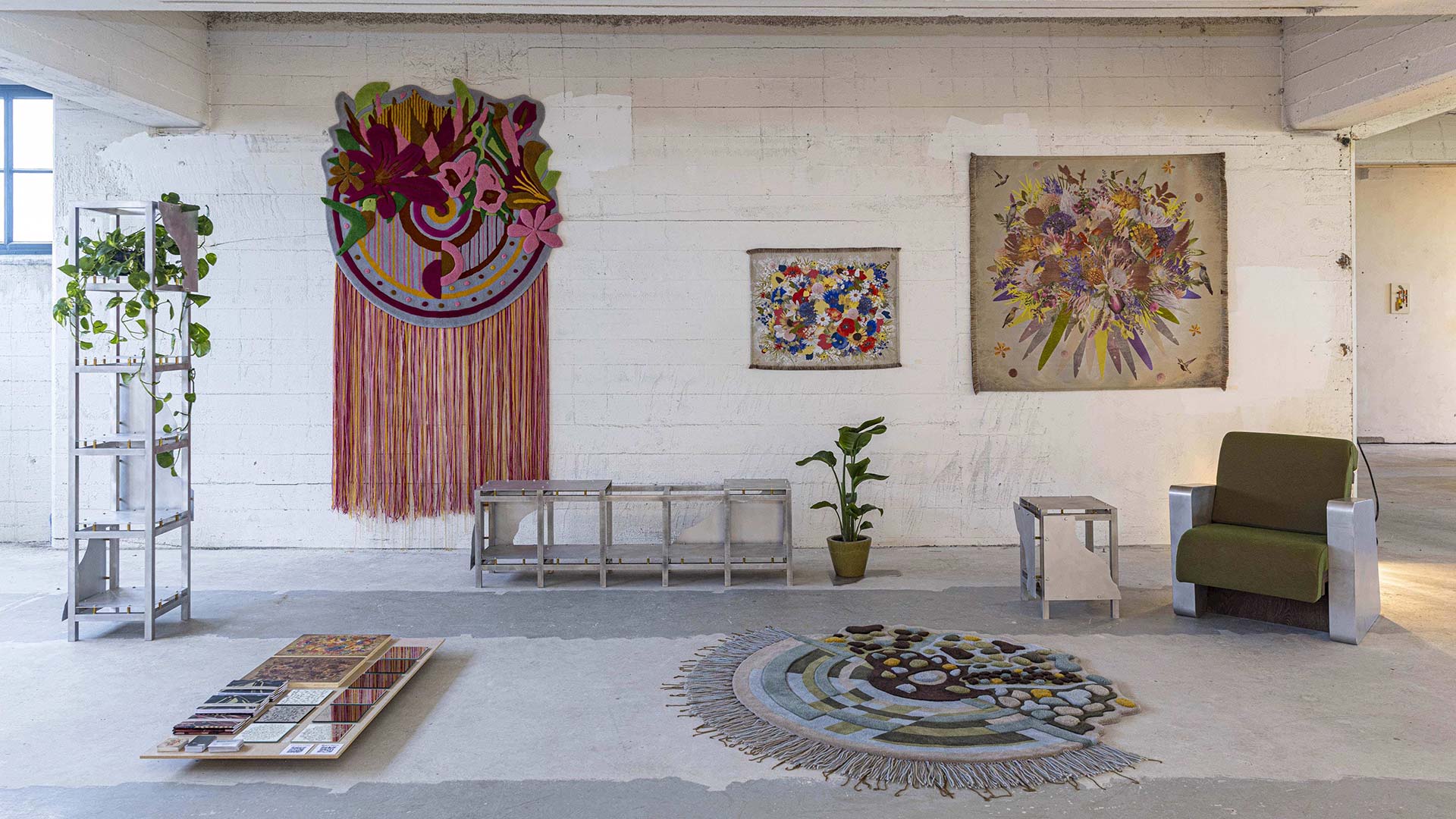A visit to Milan during Milan Design Week is hardly complete if one hasn’t visited the renowned Rossana Orlandi Gallery Milano, a landmark of contemporary design, with articles from international designers of furniture and unique pieces. They paired up with print and textile designer Tjitske Storm to present her story-imbued tapestries for the first time during Milan Design Week 2023. Titled ‘The Art of Living Together,’ the collection of limited-edition tufted and woven tapestries tap into Storm’s expressive style that forwards intuition through a dynamic synergy of opposite worlds, visible through the combination of geometric and organic shapes, detailed photographic assemblages versus abstract illustrations, and the implementation of digital techniques and tactile crafts.
“Through exploring and interchanging contradictions and perspectives, conceptually and visually, (I) aim to underline both the unity and the diversity of life,” shares the Netherlands-based designer who worked with Marcel Wanders Studio before establishing her own practice, and subsequently collaborating with brands like Moooi, Ted Baker, Kek Amsterdam and Revised for diverse custom projects.
‘The unity and diversity of life’ is portrayed in the Dutch designer’s eye-catching graphics and textile art, beginning with ‘Zebra & Ostrich,’ a two-metre-long, organic-shaped, hand-tufted and handknitted tapestry with a story—"Ostriches and zebras are depending on each other’s senses. Ostriches are slightly hard of hearing and have a poor sense of smell while their eyesight is exceptional. Zebras on the other hand have weak eyesight but a great sense of smell and hearing. These two animals warn each other from predators, through smart use of each other’s senses: a mutualistic symbiosis,” shares Storm.
For ‘The Art of Living Together,’ Storm sought inspiration for the concept while travelling in Angola and South Africa, to culminate in three hand-tufted tapestries and one Jacquard woven tapestry, that conceptually and visually translate her ‘fascination for evolution and the natural phenomenon of symbiosis.’ “The interaction between different species is emphasized through the correlation of the geometric and the organic, the abstract and the detailed, the digital and the tactile, the East and the West, the North and the South, and the old and the new. Dissimilar worlds that smoothly collide, interact and enforce each other,” she adds.
According to the creator, ‘Symbiosis’ remains one of the major forces behind evolution, where animals, plants, fungi and organisms cooperate to survive by means of contributing to each other. This close and symbiotic relationship between two dissimilar species has often had a long history of interdependent co-evolution. ‘Mutualism’ is regarded as the collaboration between dissimilar species, where both species mutually benefit, with neither being able to survive without the other. ‘Commensalism’ is described as the association between dissimilar species, where one species benefits, while the other neither benefits nor is harmed. These are the evolved relationships between natural organisms that are explored at length in the creative approach as well as the resulting tapestry designs of the collection which will be exhibited at Rossana during Milan Design Week 2023.
For instance, the ‘Chameleon & Lichen’ rug design made of New Zealand wool and metal chains taps into the mutualistic- commensalistic-symbiosis between the two; Lichen, a fungi that lives with algae or bacteria, can be found on trees, rocks and stones. Without each other, these organisms would not survive—'mutualistic symbiosis.’ The chameleon blends in with the lichen owing to their similar appearance, which guards the chameleon as it stays invisible from its predators. Therefore, the lichen remains unharmed while the chameleon benefits from it—'commensalistic symbiosis.’
The ‘Sunbirds & Tropical Flowers 2.0’ textile design forays into a tropical, flowery tale. The author relays—"Most tropical flowers are colourful and have long tubular calyx full of sugary nectar. These plants have customised and adjusted their shape and size for the beaks of local sunbirds, to be exclusively available for them. Sunbirds also feed on all the insects that visit the flower, and this helps in protecting the flower from being eaten—mutualistic symbiosis.”
For the tapestries ‘Zebra & Ostrich,’ ‘Chameleon & Lichen,’ and ‘Sunbirds & Tropical Flowers 1.0,’ Storm transformed her drawings digitally into 3D reliefs and textile structures through ancestral tufting techniques. The tapestries were then hand tufted by artisans in India, with the utmost care. New Zealand Wool of the highest quality was employed for the tapestries, ensuring durable and soft results, while the yarns are coloured with natural and chemical-free ingredients. For the ‘Sunbirds & Tropical Flowers 2.0,’ tapestry, Storm selected, re-coloured, altered, and adjusted various elements of more than 100 images and photos, to reach the product design’s bursting composition. She then translated this digital artwork to Jacquard woven textile using various weaving techniques. The yarns used are from Pure New Wool, (Mercerized) Cotton and NewLife® Polyester, and are made within a sustainable textile production in The Netherlands.
STIR’s coverage of Milan Design Week 2023 showcases the best exhibitions, studios, designers, installations, brands, and special projects to look out for. Explore Euroluce 2023 and all the design districts—5Vie Art and Design, Brera Design District, Fuorisalone, Isola Design District, Tortona District, and Milano Design District—with us.






 Sign in with email
Sign in with email










What do you think?